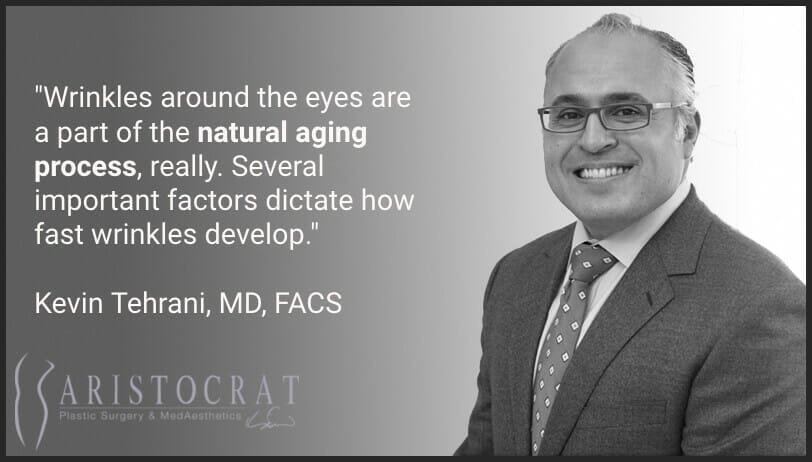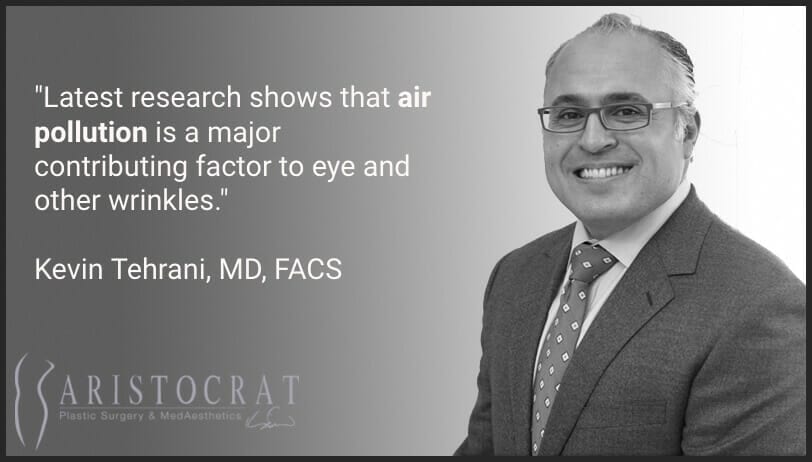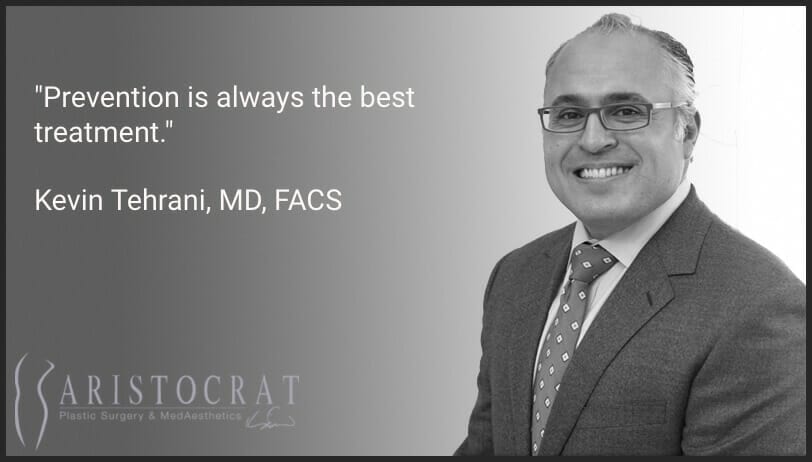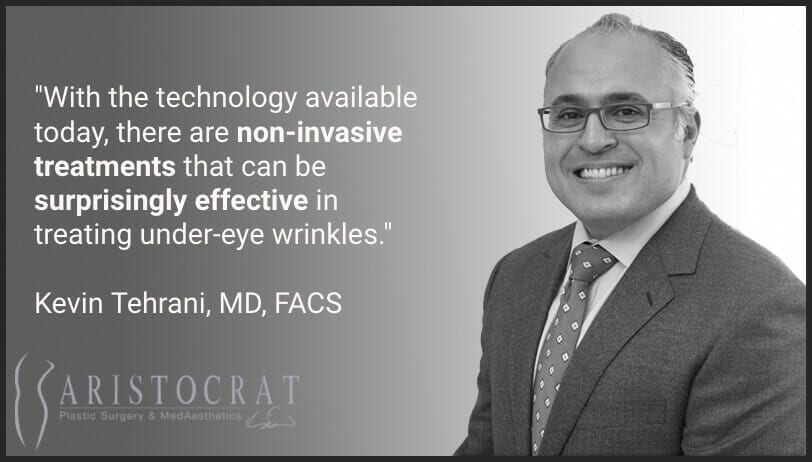What Causes Sudden Under Eye Wrinkles, and How to Get Rid of Them
There’s a breakpoint in each and everyone’s lives when looking in the mirror after a night’s sleep stops being a silent cheer and instead becomes a reality check.
The cheeks look alright. The teeth you’ve recently done. But the wrinkles… The wrinkles give it all away.
Funnily enough, wrinkles around the eyes are scientifically shown to signal friendliness and sincerity. We do contribute to our wrinkling processes when we laugh, after all.
However, try telling that to your morning self. She does not accept the wrinkles, and she will do whatever is in her power to get rid of them.
We’re here to help.
*Video Summary
What Causes Unexpected Under Eye Wrinkles?
Wrinkles occur naturally as we age, but environmental factors and habits are also major contributors to sudden skin changes.

REASON #1: AGING
Big surprise! The skin around our eyes starts to wrinkle as we age.
But why exactly does it happen?
The overall health of our skin directly depends on several important elements in our body, all of which get affected with age:
- Collagen is one of the most abundant proteins found in our body. Present in bones, muscles, tendons and the dermis (middle layer of the skin), this protein is responsible for forming a scaffold that provides firmness and structure to many of our body structures. Here are a few facts about collagen:
- Some types of collagen molecules are stronger than steel.
- Collagen attracts new cells to damaged or worn out bodily fibers.
- By the age of 60, bodies produce dramatically less collagen.
- Collagen contributes to the firmness of our skin.
- Elastin. Elastin is a key extracellular matrix protein that is critical to the elasticity and resilience of many vertebrate tissues including large arteries, lung, ligament, tendon, skin, and elastic cartilage. Long story short: elastin makes your skin elastic and prevents wrinkles. A few facts about elastin:
- Elastin helps skin tissue return to its normal state
- Elastin helps blood flow through vessels, which improves collagen supply to the skin
- Elastin and collagen are two main structural components of the skin
- Glycosaminoglycans (GAGs) are responsible for keeping the skin hydrated. In general, Glycosaminoglycans (GAGs) are a family of highly sulfated, complex, polydisperse linear polysaccharides that display a variety of important biological roles. GAGs are instrumental in enabling proteins—such as collagen and elastin—to do their job properly.
Reason #2: Environmental and Sun Damage
In addition to naturally lower levels of collagen, elastin and GAGs (introduced in previous section), certain “outside” factors also have a huge impact on how well our bodies produce, absorb and utilize these proteins and cells.
Some environmental factors also have a more direct effect on skin wrinkling around the eyes.
Smoking
Can smoking cause wrinkling under the eyes? Yes, it can, and it’s actively doing so.
However, tobacco usage is considered to contribute to skin wrinkling only after 10 years of consistent smoking.
How exactly does smoking cause your skin to wrinkle?
One of the main reasons why smoking can be a huge contributor to your eye wrinkles is because the nicotine forces your blood vessels to narrow, restricting the access of oxygen, collagen, elastin, Vitamin A, and other proteins and nutrients to the skin.
Which means that—even if you’re in your 30s and your collagen and elastin levels are normal, nicotine effectively prevents these nutrients to reach the dermis to restore your skin’s firmness and elasticity.
While narrowed blood vessels are the main reason why smoking is so bad for your eye skin, the troubles don’t end there.
Many harmful chemicals found in the tobacco smoke (read: besides nicotine) interfere with collagen and elastin production throughout your body, and break down existing collagen and elastin molecules.
Which means smoking doesn’t just cause temporary wrinkles: it systematically disables your body’s ability to regenerate skin’s firmness and elasticity.
Sun Exposure and Ultraviolet (UV) Rays
Did you know that your suntan is nothing but your body’s protective reaction towards UV radiation?
According to the World Health Organization (WHO), there is no such thing as a “healthy suntan.”
The reality is that extensive exposure in the sunlight causes damage to your body in a number of ways:
- Sunburn. In the mildest of forms, a sunburn means light redness and irritation. In most severe cases, a sunburn can cause blisters and peels. Either way, we should call it what it is: dead or severely damaged skin cells, caused by UV radiation.
- Photosensitivity. Some percentage of the population suffers from an increased sensitivity towards sun rays and UV radiation. This effectively crosses off all suntanning activities and limits them to long-sleeve options. Certain medications can also cause increased photosensitivity.
- Skin cancers. Our goal is not to scare you off your next beach vacation, but you should know that UV radiation is a major factor in developing non-melanoma and melanoma skin cancers.
As far as wrinkling is concerned, UV radiation has a significant role to play here as well.
The main reason why UV radiation causes skin wrinkling under your eyes is because it interferes with cellular activity in the dermis and epidermis.
Basically, what happens is due to your skin’s natural defensive reaction, the cellular layers underneath the skin thicken, making it more difficult for collagen and elastin to renew and restore dead or damaged skin cells. This eventually leads to “older”, less elastic skin.
Besides direct effect of the UV rays on our molecular processes, there’s a more direct reason why direct sunlight is so bad for your eye wrinkles: squinting!
If you’re not on good terms with sunglasses, years of constant squinting eventually take their toll, causing the area around your eyes to wrinkle.
Air Pollution
There are well established links between air pollution in some of the world’s busiest cities and a number of lung diseases, forms of diabetes and even mental illnesses.
Recently, however, scientists have discovered another major harmful effect of air pollution: skin aging.

In fact, some say that the level of air pollution could be the most significant factor in skin wrinkling and overall health.
To break it down in the simplest way possible, polluted city air often includes harmful amounts of “tiny particles called PMs, nitrogen dioxide (NO2) and chemicals such as polycyclic aromatic hydrocarbons (PAHs).”
A recent major study has found that particulate matter (PM) has a significant effect on how well our skin ages. What’s even scarier that the pollution doesn’t stop at our home’s doorstep. Over 30 households were tested for indoor PMs, and significant damage to the skin of inhabitants was observed.
In one of their most recent studies, the same group of researchers found that nitrogen dioxide (NO2) can also be a major contributor to skin aging and wrinkling, at the same time when pollution in many of the world’s largest cities—including London—are reaching record levels.
Reason #3: Sleeping and Other Habits
Believe it or not, your small everyday habits can have a lasting impact on the wrinkling around your eyes and face.
We understand that changing these habits can be extremely difficult, and, quite frankly, they are not your biggest enemy while combating eye wrinkles.
However, it is still good to know which habits affect the skin around your eyes.
Sleeping on Your Belly
Most of us prefer to sleep on our belly. However, this may eventually lead to deeper, more prominent under eye wrinkles.
The biggest reason why sleeping face-down is bad is because you never actually sleep facing the pillow—you’d have a hard time breathing otherwise.
No, when you sleep on your belly, you put your head to the side, causing the skin around one of the eyes to crump. This can eventually lead to permanent under eye wrinkling.
What’s even worse is that if you tend to sleep on one side more than the other, skin wrinkling can become uneven between the two eyes.
To learn how to deal with this, read the following section, “How to Prevent Wrinkles Under the Eyes?”
Rubbing Your Eyes
Most of us rub our eyes when we’re tired and sleepy. Prolonged activities that require intense visual effort—such as reading a book, driving long distances or staring at a computer screen—also cause strain onto our eyes.
Unfortunately, the skin around the eyes is so think that rubbing it causes significant wrinkling.
While it definitely doesn’t mean that you’ll have permanent under-eye wrinkles after a couple of intense “rubbing sessions”, these effects do add up, and could cause permanent wrinkling eventually.
Common Facial Expressions
It is no secret that expressive people usually have the most wrinkles—the names “smile wrinkle” and “angry wrinkle” are there for a reason, after all.
As far as eye wrinkles are concerned, all facial expressions that cause frowning and squinting can become major contributors to the wrinkles around our eyes.
Does this mean you should stop laughing so much? By no means! In fact, studies show that eye wrinkles subconsciously make us think that the other person is happier and more sincere.
How to Prevent Wrinkles Under the Eyes?
As with many areas of medicine, prevention is the best treatment. Under eye wrinkles are no exception.
Here at Aristocrat Plastic Surgery, we always focus on preventative approaches first.

There are many things you can do to prevent significant eye wrinkling, without having to sacrifice the laughter and the sunbathing:
- Use a strong SPF cream. Don’t take any chances—UV radiation is the most common, and most dangerous contributor to under eye wrinkles.
- Wear hats. Covering your face with a baseball cap or a sun hat will go a long way in preventing your eyes from direct UV exposure.
- Wear sunglasses. This one’s an absolute must. Not only quality sunglasses will block the major part of the UV radiation, it will also stop you from squinting and frowning. Probably the best investment you can make to prevent under eye wrinkles if you frequent sunny areas.
- Sleep on your back. We know how hard changing your sleeping habits—or any habits, for that matter—can be. But if, by any chance, you can retrain yourself to sleep on your back, your eye skin will be very thankful in the long run. Or, you could always get a…
- Special belly sleep pillow. There are special anti-aging pillows on the market that allow you to sleep on your belly without putting any pressure on your eye skin.
- Stop or reduce smoking. No other way to put it—the more you smoke, the more the nicotine and other 4,000 harmful chemicals will impact the way your skin ages.
- Move to a less polluted location. While still in the early stages, new air pollution studies find that PMs and NO2 have a significant and lasting impact on our skin. While living downtown may provide logistical advantages, it will take a toll on your under eye skin.
- Keep your skin moisturized. While we wouldn’t fall for the “collagen cream” trick—simply because collagen molecules are too large to be absorbed via the skin—keeping your skin moist is a good idea at all times. Aloe vera, honey and lemon are historically shown to have tremendous anti-aging effects.
How to Treat Eye Wrinkles?
There are several non-invasive techniques that enable patients to battle under eye wrinkles without undergoing the knife.

Rarely do non-invasive procedures compare to surgical ones in their effectiveness. Under-eye wrinkle treatment is one of those rare exceptions.
Laser resurfacing is a relatively new technology, that, well, aims to “resurface” your new and elastic skin that’s buried underneath the old, damaged layer, removing wrinkles along with the dead skin layers.
How does the technology work?
Basically, the lasers used during the procedure target a fraction of your skin at a time. When the skin is “heated up”, a couple of things are happening at the same time:
- Old, surface-level skin layers are removed
- New, fresh skin layers are stimulated
These same lasers also stimulate your skin’s production of collagen, so the skin that grows back is even younger, smoother, and healthier than before.
How Long Does Laser Resurfacing Take?
One of the best things about the laser technology we use is that only 1-2 sessions are sufficient to create a significant, lasting impact on your eye wrinkles.
The procedure usually takes 20-30 minutes.
How to Prepare for Laser Skin Resurfacing?
Generally, no special preparation is needed for laser resurfacing; however, a few guidelines apply to all cosmetic procedures:
- Stop smoking at least 2 weeks before the procedure, as it can prolong and otherwise impact the healing process
- Your doctor may prescribe you to avoid certain supplements and medications that may interact with the resurfacing procedure or the recovery
Does Laser Resurfacing Work? Who Is the Best Candidate?
The short answer is: yes, it does work.
It’s one of the most effective procedures out there today for patients who want to tackle facial wrinkles.
However, there are several factors that will determine how effective laser resurfacing will be for a particular patient:
- Wrinkle depth. Due to the nature of the procedure, surface-level wrinkles are easiest to “remove”. The general rule of thumb is: a high number of small wrinkles is good, a small number of deep wrinkles is bad for this particular procedure.
- Nature of the wrinkles. Wrinkles that are caused by intense repeated facial expressions usually have deeper “roots” in our skin, which will make the resurfacing procedure less effective. Wrinkles caused by UV radiation, natural aging and environmental factors (air pollution) are best suited to be removed with the laser technology.
- Color of the skin. Due to the fact that the laser interacts differently with every skin pigment, patients with brighter skin pigmentation tend to see the best results for laser resurfacing.
Radiofrequency Therapy and Ultherapy vs. Laser Resurfacing
There are a couple of other skincare techniques we use here at Aristocrat Plastic Surgery to achieve similar results.
Radiofrequency (RT) therapy uses radio-frequency waves (electromagnetic waves at wavelengths of between 1 km and 1 cm) to stimulate regenerative processes in the skin.
Ultherapy, much like the previous option, uses ultrasound energy to stimulate collagen production.
To put it in plain English, each of these three procedures has a specific niche where they’re most effective:
- Laser resurfacing is best for patients with bright skin and multiple surface-level wrinkles
- Radiofrequency treatment is a good alternative for patients with darker-pigmented skin or increased skin photosensitivity
- Ultrasound therapy can tackle deeper skin layers (3-3.5 mm), which makes it a good non-invasive option for patients with deeper, more pronounced wrinkles
Another Big Difference: Recovery Downtime
One of the biggest factors for patients is the amount of recovery downtime required after the procedure.
While this is different in every individual case, it can be generalized that:
- Laser resurfacing will require at least 1-2 weeks of “social downtime” while your skin heals
- Radiofrequency and Ultherapy treatments require no-to-minimum downtime; usually, patients can resume their normal activities with no downtime
Chemical Peel: Effective, but Not the Best Choice for Everyone
Chemical peels work in a very similar way to laser resurfacing: they remove the upper layers of aged, wrinkled skin to allow the newer, more elastic skin to “resurface.”
The biggest difference is that whereas laser resurfacing uses the concentrated power of light to remove the old skin layers, chemical peels use—you guessed it—chemicals like hydroxy acid, glycolic acid or trichloroacetic acid — to deeply exfoliate the skin and eventually cause the top dermal layers to peel off.
In terms of recovery and procedure times, chemical peels are very similar to their non-chemical counterparts.
As a general rule of thumb:
- Deeper chemical peels will achieve more dramatic results in fewer sessions
- Lighter chemical peels will require more sessions to achieve similar results
However, some patients may be allergic to certain chemicals used during the peel, which makes them a good candidate for alternative procedures.
Others may simply dislike the idea of a chemical peel.
Final Verdict: There Are Effective Non-Invasive Ways to Get Rid of Under Eye Wrinkles
Wrinkles around the eyes occur for a number of reasons.
First of all, wrinkling is a part of our natural aging process. As we get older, two very important nutrients—collagen (responsible for renewal and firmness of the skin) and elastin (responsible for elasticity and laxity of the skin) — are produced in much lower quantities compared to someone in their 20s.
Secondly, a number of environmental factors contribute—either directly or indirectly—towards the wrinkles in our skin and around the eyes. Smoking, suntanning and living in air-polluted neighborhoods have been clinically and practically shown to speed up the aging processes of the skin.
Lastly, some of your sleeping habits and facial expressions may have an impact on how eye wrinkles develop. Sleeping on your belly, frequently frowning and squinting have been shown to speed up the wrinkling process around the eyes.
If the wrinkles have already formed and lifestyle changes won’t be enough, there are highly effective non-surgical options available—such as radiofrequency therapy, ultherapy, laser resurfacing and chemical peel.
References
1.https://www.medicalnewstoday.com/articles/322151.php
2.https://www.medicalnewstoday.com/articles/322151.php
3.https://www.livestrong.com/article/78360-collagen-functions/
4.https://www.medicalnewstoday.com/articles/262881.php
5.https://www.scientificamerican.com/article/why-does-skin-wrinkle-wit/
6.https://www.sciencedirect.com/topics/neuroscience/elastin
7.https://www.sciencedirect.com/topics/neuroscience/glycosaminoglycans
8.https://www.mayoclinic.org/healthy-lifestyle/quit-smoking/expert-answers/smoking/faq-20058153
9.https://www.who.int/uv/faq/uvhealtfac/en/index2.html
10.https://www.who.int/uv/faq/uvhealtfac/en/index2.html
13.https://www.nature.com/articles/s41598-017-15295-8
14.http://www.jidonline.org/article/S0022-202X(16)00453-X/abstract
15.https://www.health.com/beauty/smile-wrinkle-lines
17.https://www.aloe-medical-group.com/en/aloe-vera/history.html
18.https://www.aristocratps.com/non-surgical/fraxel-repair-co2-laser-resurfacing/
19.https://www.aristocratps.com/non-surgical/fraxel-repair-co2-laser-resurfacing/
20.https://www.aristocratps.com/non-surgical/thermismooth-new-york/

